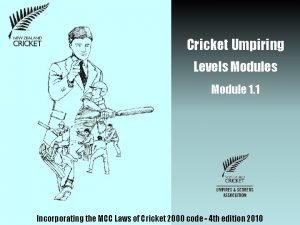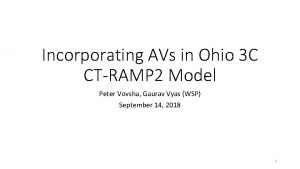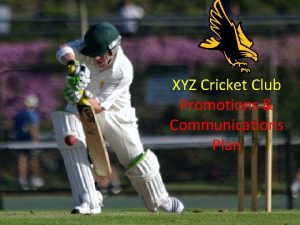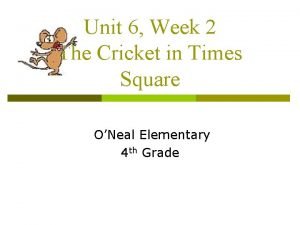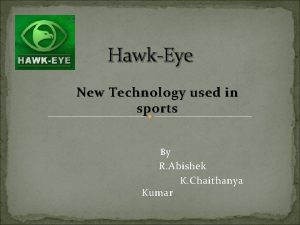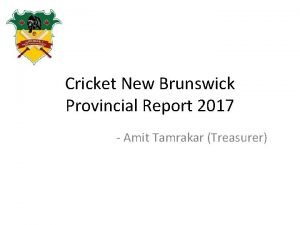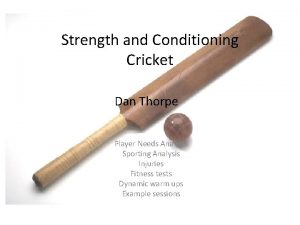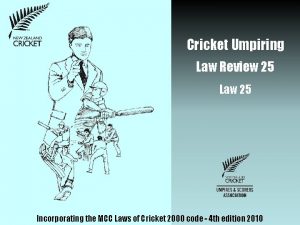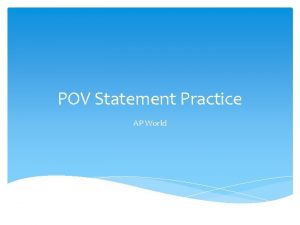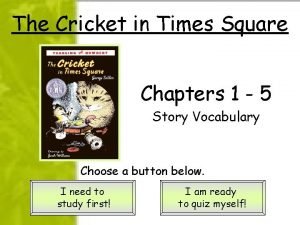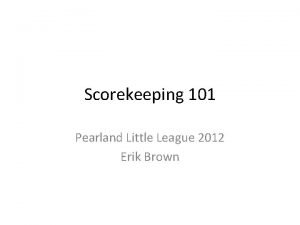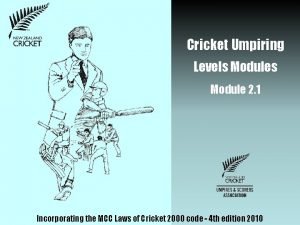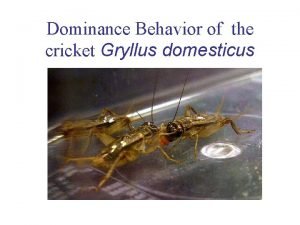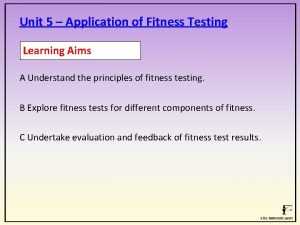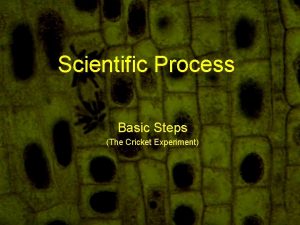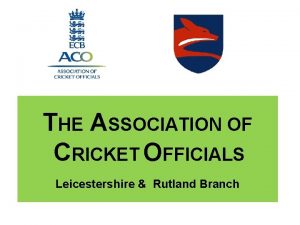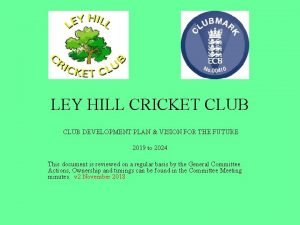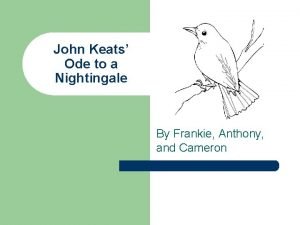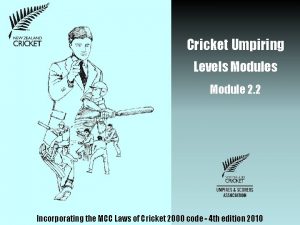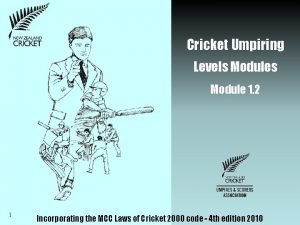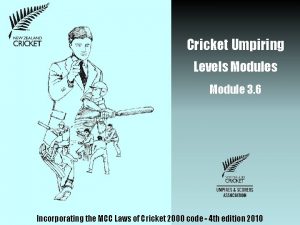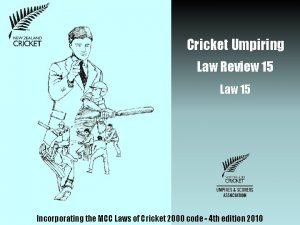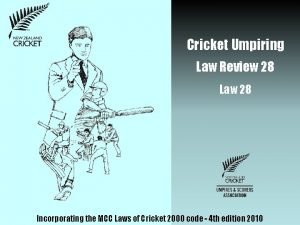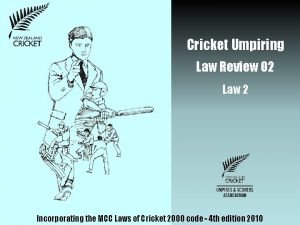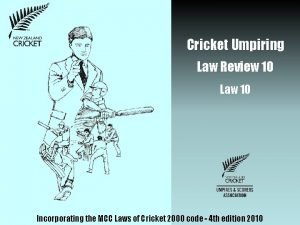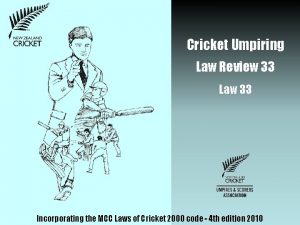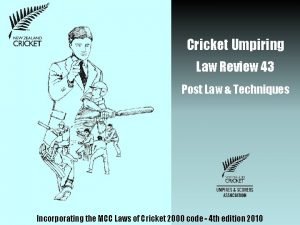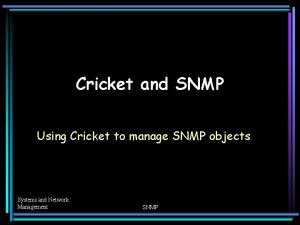Cricket Umpiring Levels Module 3 3 Incorporating the



















































































- Slides: 83

Cricket Umpiring Levels Module 3. 3 Incorporating the MCC Laws of Cricket 2000 code - 4 th edition 2010

This module In this module we will review 2 Law 5 Law 20 The ball Lost-ball Law 22 Law 24 The over No-ball Law 23 Law 25 Dead-ball Wide-ball Law 33 Handled the ball Law 34 Law 42 Hit the ball twice Fair & unfair play

Law 6 – The ball The specifications of the ball vary dependant on the grade of cricket being played. . . It may be of 2 or 4 -piece construction of any colour MEN SIZE- circumference not more than 9 inches (22. 9 cm) and not less than 8 13/16 inches (22. 4 cm) WEIGHT 3 WOMEN 8 7/8 inches (22. 5 cm) 8 ½ inches (21. 0 cm) not more than 5 ¾ ounces (163 grams) 5 5/16 ounces (151 grams) and not less than 5 ½ ounces (155. 9 grams) 4 15/16 ounces (140 grams) This shows how important it is that all balls be confirmed before the match

Approval & control The umpires must approve all the match balls before the toss They must take and retain possession of all the balls. . . before the toss at the fall of a wicket at the start of any interval or interruption New ball 4 Unless agreed otherwise before the match … either captain may demand a new ball at the start of each innings

The ball New ball in match of more than 1 day’s duration. . . The fielding captain can demand a new ball after prescribed number of overs has been bowled with old one … as decided by Governing Body of the relevant country … but this cannot be less than 75 overs New Zealand Cricket requires … 80 overs to be bowled before a new ball can be taken 5 Unlike the law on a Follow-on … if no play is possible on day-one the duration of the match remains unchanged for this law

The ball Notification When a new ball is taken the umpires must. . . inform the batsmen at the crease and the scorers - using the prescribed signal When this signal is acknowledged play may resume If a new ball is taken mid-over that part over counts as a full over when calculating when the next new ball may be taken 6

The ball Irregular checking of the ball The umpires must make frequent & irregular checks on the ball. . to ensure it has retained its integrity. . . normal wear & tear accepted and has not been unlawfully tampered with by players Ball gauges 7 Ball gauges are available to assist the checking of the ball Two rings The ball should pass through one ring but not the other

Law 20 – Lost-ball The call of “Lost-ball” is a rare event in the modern game The ball must become lost, or be irretrievable … within the field-of-play How can the ball become lost ? It can drop down a hole inside the boundary or it can lodge in the branches of an overhanging tree overlooked during the pre-match inspections If the ball is lost outside the boundary, a boundary is scored That is NOT a Lost-ball as provided in this Law Hence the importance of pre-match inspections 8

Law 20 – Lost-ball On the call of “Lost-ball” the ball becomes automatically dead A farcical situation could develop as the batsmen continue running while the fielders attempt to retrieve the ball Umpires should resist the temptation of stepping in to stop play 9

Law 20 – Lost-ball – How scored On the call of “Lost-ball” the ball becomes automatically dead A MINIMUM of 6 runs must be added to the score If batsman have run more than 6 runs … all runs completed are scored including the run in progress at the instant of the call … provided they have crossed DO NOT add the runs scored to the 6 runs awarded It is whichever is the greater … 6 runs OR the runs scored by running All runs are credited to the striker … or to appropriate extras 10 RECORD the incident in your note book to provide assistance to scorers during the next interval

The replacement ball If the ball needs to be replaced … because of damage or the loss of the original its replacement must be of comparable usage Any lost time is not made up because of the ball being replaced NOTE A replacement ball is NOT a new ball The umpires must advise both batsmen and the fielding captain that the ball has been replaced RECORD this in your note book to assist the scorers 11

Law 22 – The over An over comprises 6 balls (called Valid balls) bowled from alternate ends of the pitch An over starts when the bowler starts his run up or his bowling action 12

Law 22 – The over If the bowler does not have a run-up the over starts when the bowler starts his delivery action The umpire must call OVER when the ball becomes dead after 6 valid balls have been bowled 13

Law 22 – The over An over comprises 6 legitimate deliveries Only valid deliveries are counted Balls not counted are Bowling extras No-balls & Wides Balls that have bounced MORE than twice or have rolled along the ground or have come to rest in-front of the striker’ wicket Balls called DEAD before the striker has had a chance to play at it These balls must be re-bowled 14 unless the innings is closed They are NOT additional balls of the over

Law 22 – Umpire miscounting If the umpire miscounts the balls of the over The miscounted over stands Umpires should signal each other when 4 balls have been bowled 15

Law 22. 5 (b) – Umpire miscounting On rare occasions after 6 valid balls have been bowled in an over, an umpire having miscounted, may permit another delivery in the over When the ball becomes dead and having becoming aware of the miscount he must immediately call OVER If the additional delivery was an invalid ball i. e. a NO-BALL or WIDE he must accept the error and NOT permit the invalid ball to be re-bowled 16

Law 24 – Definition of a fair delivery The arm The ball is fairly delivered if when the bowler’s arm has reached the level of the shoulder in the delivery swing and the elbow joint is not straightened or bent until the ball has left the hand Flexing or rotating the wrist is permitted Should the bowler offend one umpire must call & signal NO BALL 17 The ultimate sanction against offenders occurs after the 3 rd offence

Degree of certainty The umpire must have a high degree of certainty that the ball has been unfairly delivered It is not sufficient for him to believe it might have been unfair Only if absolutely certain then one umpire must call & signal NO BALL 18

Attempt to Run-out the striker BEFORE delivery the bowler is permitted to attempt to throw the ball to the striker’s end in an attempt to run-out the striker There is only a brief window of opportunity for the bowler to attempt this The ball must be in-play It must occur BEFORE the bowler enters his delivery stride 19

Attempt to Run-out the striker BEFORE delivery the bowler attempts to run-out the striker If successful. . . either umpire must call & signal NO-BALL then DEAD-BALL On Appeal the striker must be dismissed - Run-out - NOT Bowled That invalid ball is NOT counted as a ball of the over It was a No-ball 20 Therefore it must be re-bowled Ensure the scorers record the dismissal correctly RECORD the incident in your note book

Attempt to Run-out the striker BEFORE delivery the bowler attempts to run-out the striker If unsuccessful. . . or if the bowler attempts to run-out the striker after entering his delivery stride. . . either umpire must call & signal NO-BALL and allow play to continue as for any other No-ball That invalid ball is NOT counted as a ball of the over It was a No-ball Therefore it must be re-bowled 21 RECORD the incident in your note book

Ball bouncing more than twice If the ball bounces more than twice - i. e. 3 or more times or rolls along the ground The umpire must call & signal NO-BALL The striker may hit this ball & score runs provided 22 the ball does not stop in-front of his wicket

Ball not reaching the striker If the ball comes to rest in-front of the striker. . . The umpire must call & signal DEAD-BALL then NO-BALL 23 A free hit is NOT permitted

No-ball – other issues If NO-BALL is called and the ball is not delivered the umpire must revoke the call The call & signal of NO-BALL negates a WIDE The ball is NOT dead on the call of NO-BALL It remains in-play until it becomes dead otherwise A NO-BALL is not counted as a ball of the over It must be re-bowled NO-BALL must be signalled twice 24 with a CALL the instant of an offence and repeated to the scorers when the ball becomes dead

Penalty for a No-ball A penalty is invoked on the call & signal of NO-BALL 1 run is awarded INSTANTLY and is scored irrespective of what happens next A No-ball is a Bowling extra debited against the bowler The 1 run penalty is scored as a No-ball extra 25 Any runs which ensue from that delivery are scored and are credited to the striker provided he hit the ball with his bat or as No-ball extras – if he did not Signalled as a No-ball then Bye

Runs scored off a No-ball 1 run is scored as a penalty on the call of NO-BALL The striker is credited only with any runs scored off his bat The only additional signal necessary may be a Boundary 4 or 6 If he fails to hit the ball with his bat and runs are scored these are always scored as No-ball extras and Byes must be signalled, followed if necessary by Boundary 4 A boundary 6 can only be scored – off the bat Any other penalty for illegal fielding are always signalled and recorded as PENALTY RUNS 26

No-ball / Bat - examples NO-BALL called & signalled 1 No-ball extra scored as a No-ball extra The striker hits the ball and 3 runs are completed 3 Runs credited to the striker TOTAL 4 Runs All debited against bowler NO-BALL called & signalled 1 No-ball extra scored as a No-ball extra The striker hits the ball over the boundary 6 Runs credited to the striker TOTAL 7 Runs All debited against bowler 27

Law 23 – Dead ball The ball is either in-play or it is dead Because it is an inanimate object and not capable of life … it should not be described as being Live The ball comes into play. . that is in-play when the bowler starts … his run-up or bowling action When the ball becomes dead … it is no longer in-play This is the subject of this law 28

Law 23 – Dead ball There are 10 occasions when … the ball becomes dead automatically There is 1 occasion when … the ball is deemed dead There are many occasions when … an umpire is required to … call & signal DEAD-BALL This is a prime law 29

Law 23 – Dead ball The ball becomes dead AUTOMATICALLY when … When the ball has FINALLY settled is for the umpire to decide (i) it finally settled in hands of the wicket-keeper 30 or the bowler

The ball is automatically dead The ball becomes dead AUTOMATICALLY when … 31 (ii) a boundary is scored (iii) a batsman is dismissed

The ball is automatically dead The ball becomes dead AUTOMATICALLY when … (iv) it becomes trapped between the bat and person of the striker or between items of his 32 clothing or equipment

The ball is automatically dead The ball becomes dead AUTOMATICALLY when … (v) it LODGES in the clothing or equipment of a batsman 33 or the clothing of an umpire

The ball is automatically dead The ball becomes dead AUTOMATICALLY when … (vi) it LODGES in a protective helmet worn by a fielder 34 (vii)illegal fielding takes place or the ball hits helmet behind the wicket-keeper

The ball is automatically dead The ball becomes dead AUTOMATICALLY when … (viii) There is an award of Penalty runs because a player returned to field-of-play without umpire consent and made contact with the ball in-play 35 (ix) A fielder calls “Lost-ball” (x) The umpire calls OVER or TIME

The ball is considered dead If the bowler’s end umpire is satisfied that the fielders and BOTH batsmen have ceased to regard the ball as being in-play the ball is deemed dead That is … the fielders are showing no interest in taking a wicket and the batsmen have lost interest in scoring runs While the ball may be considered dead by the players 36 it is advantageous if the umpire calls DEAD-BALL

CALL & signal of DEAD-BALL An umpire must call & signal DEAD-BALL when. . . (i) he intervenes in any case of unfair play 37

CALL & signal of DEAD-BALL An umpire must call & signal DEAD-BALL when. . . (ii) there is serious injury to … 38 a player … a batsman or a fielder or an umpire

CALL & signal of DEAD-BALL (iii) An umpire must call & signal DEAD-BALL to stop play when he wishes to leave his normal position to consult his colleague 39

CALL & signal of DEAD-BALL (iv) An umpire must call & signal DEAD-BALL when a bail falls from the STRIKER’S wicket BEFORE he has had an opportunity to play the ball 40

CALL & signal of DEAD-BALL (v) An umpire must call & signal DEAD-BALL when the striker is not ready to receive the delivery and … 41 if the ball is delivered he makes NO attempt to play it

CALL & signal of DEAD-BALL (vi) An umpire must call & signal DEAD-BALL if the striker is distracted by any noise or movement whilst receiving or preparing to receive the delivery 42 The distraction can be either inside or outside the field-of-play

CALL & signal of DEAD-BALL An umpire must call & signal DEAD-BALL if. . . (vii) the bowler drops the ball before delivery, or (viii) the ball does not leave the bowler’s hand with the sole exception of him attempting to run-out the non-striker (ix) or the umpire is required to do so by another law 43

CALL & signal of DEAD-BALL Actions on call & signal of DEAD-BALL If the ball is called DEAD before the striker has had an opportunity to play at it … That invalid ball is NOT counted as a ball of the over it must be re-bowled If the ball is called DEAD after the striker has had a chance to play it that ball is a valid ball and is counted as a ball of the over 44 If the striker is DELIBERATELY DISTRACTED whilst preparing to receive or whilst playing at a valid ball it becomes invalid and is NOT counted as a ball of the over

Law 25 – WIDE ball Only the bowler’s end umpire can call & signal WIDE A wide ball is deemed Wide from the moment it leaves the bowler’s hand however it is not called & signalled until it has passed the striker’s wicket A delivery cannot be a WIDE if NO-BALL has been called NO-BALL has precedence over a Wide WIDE must be called if the ball passes too wide of the striker to play at it That ball should NOT be considered a Bye 45 WIDE must be signalled twice … with a CALL when the ball passes the striker’s wicket and repeated to the scorers when the ball becomes dead

What is the difference between a Wide and a Bye ? Consider these balls … These balls are outside the striker’s normal reach These balls are within his reach If the ball is outside his normal reach it must be called & signalled WIDE 46

The ball must be within his reach for him to hit it with his bat with a normal cricket stroke from where he is standing in a normal guard position If the ball is within his reach and he fails to hit it and runs 47 are scored that ball must be signalled as Byes

The ball must be within his reach Off-side balls Both balls are the same distance from the striker This ball is easier to hit This ball is harder to hit 48

The ball must be within his reach Off-side balls These balls are easier to hit This ball is harder to hit 49

The ball must be within his reach Leg-side balls The lower ball is closer to the striker but it is harder to hit 50

The ball must be within his reach Leg-side balls A waist-high ball is easier to hit 51 Both balls are the same distance from the striker Is the lower ball a WIDE ?

The stature of the striker A tall batsman can reach further than a short batsman This it is important when considering calling & signalling WIDE 52

Not a Wide If the striker moves to bring the ball within his reach he negates a Wide 53

Not a Wide If the ball makes contact with the striker it cannot be called WIDE The striker cannot create a Wide by moving away Had he stayed in a normal guard position the ball would have been within his reach 54

Out off a Wide-ball Which batsman can be dismissed off a Wide-ball ? Wide Handled the ball either batsman Hit-wicket the striker Run-out either batsman Stumped the striker Obstructing the field either batsman The bowler gains credit for Hit-wicket & Stumped but not for the others 55

NOT-OUT off a Wide-ball The striker cannot be dismissed off a Wide-ball. . . Bowled Caught Hit the ball twice LBW Clearly these are impossible … The ball remains in play until it becomes dead otherwise That means runs can be scored and the striker can be dismissed in another fashion 56

Penalty for a Wide-ball A penalty is invoked on the call & signal of WIDE 1 run is awarded INSTANTLY and is scored irrespective of what happens next A Wide-ball is a Bowling extra - debited against the bowler 57 The 1 run penalty is scored as a Wide extra That delivery is not counted as a ball of the over It must be re-bowled Any runs which ensue from that delivery are also scored as Wides They cannot be credited to the striker because he cannot hit the ball with his bat The only signal which may follow a Wide is a Boundary 4

Law 33 – Handled the ball Either batsman can be dismissed Handled the ball A batsman is not permitted to touch the ball with his hand/s without a fielder’s consent This is not applicable if he uses his bat or his hand on the bat On appeal an offending batsman must be dismissed by the bowler’s end umpire A batsman is permitted to handle the ball to avoid injury This is an instinctive reaction as opposed to a deliberate act If the ball is handed back to a fielder without consent and that act prevents the fielder fielding the ball this becomes Obstructing the Field All runs completed before the offence plus any No-ball or Wide are scored 58 The bowler is not credited with this dismissal

Law 34 – Hit the ball twice The striker is permitted to hit the ball more than once for the sole purpose of guarding his wicket But. . . if when doing so he prevents a catch being taken … on Appeal. . . the bowler’s end umpire must dismiss him Hit the ball twice 59 The difficulty of the catch must not be considered

Hit the ball twice defined The act of hitting the ball twice may be … Bat Person then Bat then Person The striker may use any part of bat or body when hitting the ball twice except his hand Runs cannot be scored as a result of a 2 nd hit except … as overthrows or for Penalty runs or for a No-ball 60 This dismissal is impossible off a WIDE

Hit the ball twice Three examples of Hit the ball twice Accidental 2 or more contacts with ball in same stroke This is a legal act No umpire action is required Wilful for the sole purpose of protecting his wicket This is a legal act No umpire action is required If this occurs for any other purpose. . . it is an illegal act and the striker is subject to Appeal On Appeal the striker must be dismissed Hit the ball twice Wilful 61

Hit the ball twice – umpire action If the batsmen run following this illegal act permit the batsmen to complete one run This allows a fielder to attempt a Run-out Then call & signal DEAD-BALL before answering any appeal On Appeal a prudent umpire will call & signal DEAD-BALL and consult his colleague before answering the appeal 62 In all cases – note taking is essential

Overthrows If one throw leads to another resulting in an Overthrow and the ball reaches the boundary from the last throw only the FINAL throw is considered Only the runs completed and in progress if they have crossed after the instant of the FINAL throw are scored 63

Overthrows 2 Scenarios - overthrows 1 The striker hits the ball MORE than once and the batsmen run The batsmen have not crossed at the instant of the fielder’s throw That run – if completed IS scored 2 The striker hits the ball MORE than once and the batsmen run The batsmen have crossed before the fielder throws the ball That run – if completed is NOT scored In these scenarios. . . if the ball travels on and reaches the boundary only the boundary allowance is scored - Boundary 4 Do NOT add the runs completed to the Boundary allowance The runs scored are either. . . 64 the runs completed or the boundary – never both

Hit the ball twice & Overthrows If the ball is lawfully struck MORE than once and runs are scored as overthrows. . . the runs are recorded according to what happened to the ball first they are credited to. . . the striker Bat then Bat Person then Bat then Person the striker Leg-byes or No-ball extras The bowler gains no credit for Hit the ball twice 65

Law 34 – Hit the ball twice Three examples of Hit the ball twice 66 Accidental 2 or more contacts with ball in same stroke it is a legal act No umpire action is required Wilful If for the sole purpose of protecting his wicket it is a legal act No umpire action is required Wilful If this occurs for any other purpose it is an illegal act and the batsman is subject to Appeal On Appeal the batsman must be dismissed Hit the ball twice

Law 42. 3 – Changing the condition of the match ball The umpires are required to make frequent and irregular inspections of the ball It is unfair to attempt to change the condition of the ball Fielders are permitted to dry a wetball on a piece of cloth … or polish the ball on an item of their clothing They may NOT use any artificial substance Fielders are permitted to remove mud from aseam. . . but only under the supervision of an umpire 67 The ultimate sanction against offenders occurs after the 1 st offence

Law 42 – Tampering with the ball 1 st offence by a fielder – after umpire consultation ACTION INFORM Change the ball with one of comparable wear Your colleague Award 5 Penalty runs to the batting side The batsmen at the crease The fielding captain ASAP – The batting captain Report the incident to the Governing body 68 RECORD the incident in your note book

Law 42 – Tampering with the ball 2 nd offence by any fielder in that innings after umpire consultation ACTION INFORM Change the ball with one of comparable wear Your colleague Award 5 Penalty runs to the batting side Direct the captain to SUSPEND the bowler who bowled the preceding ball He may NOT bowl again in that innings Another bowler must complete the over 69 The batsmen at the crease The fielding captain ASAP – The batting captain Report the incident to the offender’s management & to the Governing body RECORD the incident in your note book

Law 42. 6 – Dangerous & unfair bowling The purpose of this Law is to prevent injury to the striker. . . and more particularly to his head Unfair bowling can be. . . FAST Full-tossed deliveries above waist-height of the striker SLOW Full-tossed deliveries above shoulder-height of the striker FAST short-pitched deliveries above head-height of the striker All such deliveries are unfair irrespective of their direction even if they are unlikely to cause injury If a bowler delivers such a ball the bowler’s end umpire must call & signal NO-BALL 70 The height being when the striker is standing upright at the Popping crease

Dangerous & unfair bowling Fast Full-tossed deliveries - Beamers Any FAST Full-tossed delivery is unfair if the ball passes or would have passed above waist-height of the striker when standing upright at the Popping crease The bowler’s end umpire must call & signal NO-BALL In all cases, the bowler must be given a First & Final warning His captain, the fielding captain and your colleague must also be informed 71 The striker’s end umpire can assist by indicating the height of the delivery

Dangerous & unfair bowling Full-tossed deliveries - Beamers Any Slow Full-tossed delivery is unfair if the ball passes or would have passed above shoulder-height of the striker when standing upright at the Popping crease The bowler’s end umpire must call & signal NO-BALL In all cases, the bowler must be given a First & Final warning His captain, the fielding captain and your colleague must also be informed 72 The striker’s end umpire can assist by indicating the height of the delivery

Dangerous & unfair bowling Full-tossed deliveries - Beamers New Zealand Cricket has decreed. . . that in all matches played in New Zealand that ALL full-tossed deliveries above waist-height either fast OR slow must be called & signalled NO-BALL In all cases, the bowler must be given a First & Final warning His captain, the fielding captain and your colleague must also be informed 73

Dangerous & unfair bowling FAST Short-pitched deliveries - Bouncers Any FAST Short-pitched delivery is unfair if the ball passes or would have passed above head-height of the striker when standing upright at the Popping crease The bowler’s end umpire must call & signal NO-BALL In all cases, the bowler must be given a First & Final warning His captain, the fielding captain and your colleague must also be informed The striker’s end umpire can assist by indicating the height of the delivery 74 The relative skill of the striker must be considered

Ball clearly above head-height If the ball passes CLEARLY above head-height of the striker. . . when standing upright at the Popping crease the laws required the bowler’s end umpire to call & signal NO-BALL It is an unfair delivery 75

DELIBERATE bowling offence DELIBERATE High Full-pitched deliveries are unfair If a bowler delivers any HIGH Full-pitched delivery the umpire must consider if it was DELIBERATE If he is satisfied it was DELIBERATE he must call & signal NO-BALL then the ball becomes dead direct the captain to SUSPEND the bowler forthwith Penalty runs are NOT awarded The bowler is punished by the suspension The umpire must then invoke the Reporting procedures 76 This ultimate sanction against an offender occurs after the 1 st offence

Law 42 – Dangerous & Unfair bowling 1 st offence in an innings by any bowler When the ball becomes dead. . . ACTION INFORM Call & signal NO-BALL Your colleague CAUTION the bowler The batsmen at the crease This caution applies to that bowler for the balance of that innings at both ends of the pitch 77 The fielding captain ASAP – The batting captain RECORD the incident in your note book

Law 42 – Dangerous & Unfair bowling 2 nd offence in that innings by that bowler When the ball becomes dead. . . ACTION INFORM Call & signal NO-BALL Your colleague Issue a FINAL WARNING to the bowler The batsmen at the crease This warning applies to that bowler for the balance of that innings at both ends of the pitch 78 The fielding captain ASAP – The batting captain RECORD the incident in your note book

Law 42 – Dangerous & Unfair bowling 3 rd offence in that innings by that bowler When the ball becomes dead. . . ACTION Call & signal NO-BALL Your colleague Direct the captain to SUSPEND the bowler immediately The batsmen at the crease That bowler may NOT bowl again in that innings ASAP – The batting captain Another bowler must complete the over 79 INFORM The fielding captain Report the incident to the offender’s management & to the Governing body RECORD the incident in your note book

Law 42 – Dangerous & Unfair bowling DELIBERATE High Full-pitched deliveries If any bowler bowls a HIGH Full-pitched delivery the umpire must consider if it was DELIBERATE If so. . . he must call & signal NO-BALL When the ball becomes dead the umpire must direct the captain to SUSPEND the bowler forthwith Penalty runs are NOT awarded The bowler is punished by the suspension Invoke the Reporting procedures This ultimate sanction against an offender occurs after the 1 st offence 80

Law 42 – Penalty runs are always awarded TO the non-offending side PENALTY RUNS stand alone and are recorded in a separate line of Fielding extras PENALTY RUNS are not credited to the striker, or to any other extra, or debited against any delivery 81

The end of Module 3. 3 In the next module we will review Law 1 The players Law 2 Substitutes & Runners Law 40 The wicket-keeper Law 41 The fielder Law 42 Fair & unfair play Law 31 Timed-out Law 21 The result Law 37 Obstructing the field Law 18 Scoring runs Thank you for your attention 82 Do not forget to study your copy of The Umpires Companion

These modules were written & produced for New Zealand Cricket by the New Zealand Cricket Umpires & Scorers Association 83 © 2010 NZC-NZCUSA
 Cricket umpiring signals
Cricket umpiring signals Incorporating pronunciation
Incorporating pronunciation Incorporating the change
Incorporating the change Incorporating in ohio
Incorporating in ohio Nn
Nn Unconventional cash flow
Unconventional cash flow Nested quotations
Nested quotations Costas questions
Costas questions C device module module 1
C device module module 1 đại từ thay thế
đại từ thay thế Thang điểm glasgow
Thang điểm glasgow Quá trình desamine hóa có thể tạo ra
Quá trình desamine hóa có thể tạo ra Cong thức tính động năng
Cong thức tính động năng Thế nào là mạng điện lắp đặt kiểu nổi
Thế nào là mạng điện lắp đặt kiểu nổi Các loại đột biến cấu trúc nhiễm sắc thể
Các loại đột biến cấu trúc nhiễm sắc thể Bổ thể
Bổ thể Vẽ hình chiếu đứng bằng cạnh của vật thể
Vẽ hình chiếu đứng bằng cạnh của vật thể Phản ứng thế ankan
Phản ứng thế ankan Môn thể thao bắt đầu bằng từ đua
Môn thể thao bắt đầu bằng từ đua Thiếu nhi thế giới liên hoan
Thiếu nhi thế giới liên hoan Sự nuôi và dạy con của hươu
Sự nuôi và dạy con của hươu điện thế nghỉ
điện thế nghỉ Nguyên nhân của sự mỏi cơ sinh 8
Nguyên nhân của sự mỏi cơ sinh 8 Một số thể thơ truyền thống
Một số thể thơ truyền thống Trời xanh đây là của chúng ta thể thơ
Trời xanh đây là của chúng ta thể thơ So nguyen to
So nguyen to Tỉ lệ cơ thể trẻ em
Tỉ lệ cơ thể trẻ em Fecboak
Fecboak Các châu lục và đại dương trên thế giới
Các châu lục và đại dương trên thế giới Thế nào là hệ số cao nhất
Thế nào là hệ số cao nhất Hệ hô hấp
Hệ hô hấp Tư thế ngồi viết
Tư thế ngồi viết Hình ảnh bộ gõ cơ thể búng tay
Hình ảnh bộ gõ cơ thể búng tay đặc điểm cơ thể của người tối cổ
đặc điểm cơ thể của người tối cổ Cái miệng nó xinh thế
Cái miệng nó xinh thế Mật thư tọa độ 5x5
Mật thư tọa độ 5x5 ưu thế lai là gì
ưu thế lai là gì Tư thế ngồi viết
Tư thế ngồi viết Voi kéo gỗ như thế nào
Voi kéo gỗ như thế nào Thẻ vin
Thẻ vin Thể thơ truyền thống
Thể thơ truyền thống Các châu lục và đại dương trên thế giới
Các châu lục và đại dương trên thế giới Từ ngữ thể hiện lòng nhân hậu
Từ ngữ thể hiện lòng nhân hậu Diễn thế sinh thái là
Diễn thế sinh thái là Vẽ hình chiếu vuông góc của vật thể sau
Vẽ hình chiếu vuông góc của vật thể sau Lp html
Lp html Thế nào là giọng cùng tên? *
Thế nào là giọng cùng tên? * Làm thế nào để 102-1=99
Làm thế nào để 102-1=99 Bài hát chúa yêu trần thế alleluia
Bài hát chúa yêu trần thế alleluia Lời thề hippocrates
Lời thề hippocrates Hổ sinh sản vào mùa nào
Hổ sinh sản vào mùa nào Cricket bowling machine mechanism
Cricket bowling machine mechanism Canadian premier softball cricket league
Canadian premier softball cricket league Cricket xyz
Cricket xyz The cricket in times square theme
The cricket in times square theme Hawkeye cricket
Hawkeye cricket Sjcc cricket
Sjcc cricket Strength and conditioning for cricket
Strength and conditioning for cricket Law 25 of cricket
Law 25 of cricket Personification in on the grasshopper and the cricket
Personification in on the grasshopper and the cricket Pov statement ap world
Pov statement ap world Earls colne cricket club
Earls colne cricket club Marketing plan example
Marketing plan example Origins of cricket
Origins of cricket Sponsorship proposal for cricket tournament
Sponsorship proposal for cricket tournament The cricket in times square chapter 5
The cricket in times square chapter 5 Eric carle luna moth
Eric carle luna moth Little league scorebook
Little league scorebook Oca cricket
Oca cricket Cricket
Cricket Diary entry example
Diary entry example Little old lady from cricket creek summary
Little old lady from cricket creek summary Cricket mouthparts
Cricket mouthparts Cricket ball throw test normative data
Cricket ball throw test normative data Cricket compass
Cricket compass Rules of cricket
Rules of cricket Cricket experiment
Cricket experiment Leicestershire and rutland cricket league rules
Leicestershire and rutland cricket league rules Jiminy cricket farm issued a 30-year 8 percent
Jiminy cricket farm issued a 30-year 8 percent Jiminy cricket let your conscience
Jiminy cricket let your conscience A cricket match is divided into periods called
A cricket match is divided into periods called Cricket hockey billiards fencing
Cricket hockey billiards fencing Ley hill cricket club
Ley hill cricket club Ode to a nightingale literary devices
Ode to a nightingale literary devices
